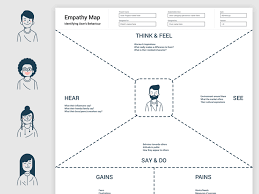Use the data gathered during your research to populate each section of your empathy map. Be sure to include user feedback from qualitative research and interviews.
Before you start, define the purpose and scope of your empathy map. Have all your materials ready to go, including a whiteboard and sticky notes.
1. Understand the Problem
Whether you’re using research, surveys, interviews, Twitter followers, or social media, gather as much information as possible on your target audience. Then, use the data you’ve gathered to help you build an empathy map(s).
An empathy map is a visual tool used to gain a deeper understanding of the user experience. It’s most effective when created based on research data, but it can also be useful for product teams during the planning stage before requirements and concepting begins.
Start by creating a persona to represent your target audience. Then, place this persona at the center of your empathy map to examine their experience. Describe this persona’s pains and gains in each quadrant. This includes what they think and feel, what they see, and what they say and do. Adding in more details about their experiences helps you identify less obvious needs, such as the desire for safety features. Ultimately, this can inform your product development process and business strategy.
2. Create a Persona
Rather than a team member being selected to be the persona to be mapped, let each participant choose the persona they want to study during the session. This can increase the sense of ownership and engagement for everyone in the room.
You might want to select a few different personas for the group to focus on, or one overarching persona that reflects your target customer base as a whole. Either way, it’s important that the persona you use is based on real customer insight — even though you may be using a fake name and age to make it easier for your team to empathize with the fictional character, those insights should still come from qualitative research or direct feedback.
Be sure to ask rich questions during the interview that generate in-depth qualitative responses that can be easily spotted and turned into data points to support the empathy map. Having rich data can also help uncover less obvious user needs.
3. Conduct User Research
In the rush to gather research data and create personas, it’s easy to overlook the real people you’re designing for. Empathy maps help teams remember to keep their users in the forefront of product development.
Conduct a series of interviews or surveys to collect user research for each of your personas. Then, organize that data into four empathy map quadrants: Says, Thinks, Does and Feels.
Put your team in your persona’s shoes by building a quick and collaborative empathy map with Miro’s virtual sticky notes. Encourage your team to fill in each quadrant with their knowledge and experience of the persona, and what they’ve gleaned from their research.
Pay special attention to the Pains and Gains sections, as these can guide your design decisions. For example, if you discover your persona cares deeply about safety features, that information will help you prioritize those features in your design process and final product. Once the empathy map is complete, zoom out and reflect on it with your team. Did it change anyone’s perspectives on the problem?
4. Build an Empathy Map
Typically, empathy maps are made in the empathize phase of the design thinking process after conducting user research. However, a quick basic empathy map can be useful in any meeting to uncover hidden user needs and guide teams into a customer-centric mindset.
Start with a user or stakeholder sketch in the center of a grid, and label it with four essential categories: Says, Does, Thinks, Feels. Collaboratively fill in the sections with sticky notes from your research, focusing on both the user’s external observable behavior and internal mindset.
Says should highlight things that users communicate verbally, ideally direct quotes from your research. Does should explore the things that users actually do. Thinks should focus on the thoughts, beliefs, assumptions, and motivations that drive their behavior. Feels should uncover their emotional state, including pains and gains. Organize the stickies on your board into clusters by similar themes and name them. This step helps you vocalize and align as a team on your understanding of the user.








